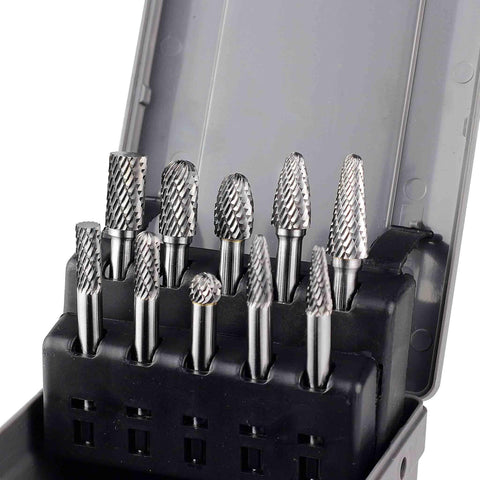+91- 11- 43790224 |
corpoffice@metrozonegroup.com

When it comes to woodworking, choosing the right drill bit can make a significant difference in the quality of your work. Among the various types of bits available, brad point bits are often considered superior to twist bits for wood-specific tasks. While twist bits are widely used for their versatility across many materials, brad point bits offer distinct advantages in woodworking that result in cleaner, more precise holes. Understanding why brad point bits are better suited for wood can help woodworkers, whether professionals or hobbyists, achieve higher quality results.
Carbide is a term that refers to a group of compounds made from carbon and a less electronegative element, most commonly a metal. These compounds are valued for their extreme hardness, durability, and heat resistance, making them crucial in a variety of industrial and manufacturing applications. Although the most well-known carbide is tungsten carbide, which is used extensively in cutting tools and wear-resistant applications, there are several other types of carbide, each with unique properties that make them ideal for specific uses. Understanding the different types of carbide can provide insight into why this material is so widely used and how it drives innovation across industries.
Tungsten carbide, the most familiar form, is a combination of tungsten and carbon. This material is incredibly hard, nearly as hard as diamond, and it's prized for its toughness and resistance to wear. Tungsten carbide is used extensively in cutting tools, such as drill bits, saw blades, and end mills, because it can maintain a sharp edge even under extreme conditions. It is also used in industrial applications such as mining and construction, where it can withstand abrasive materials and high-impact forces. Beyond industrial use, tungsten carbide has found its way into the world of jewelry due to its resistance to scratching and tarnishing, making it an appealing choice for durable, long-lasting accessories.
Another important type of carbide is silicon carbide. Silicon carbide is formed from silicon and carbon, and it is known for its ability to withstand high temperatures and its excellent thermal conductivity. Because of this, silicon carbide is frequently used in high-temperature applications, such as in the production of furnace linings, heat exchangers, and cutting tools for machining tough materials. It is also used in electronics as a semiconductor material, particularly in power electronics, where its ability to operate at higher temperatures and voltages makes it superior to silicon. Silicon carbide's hardness also makes it ideal for use in abrasive materials, such as grinding wheels, sandpapers, and cutting discs.
Boron carbide is another type that stands out for its unique properties. Known as one of the hardest materials after diamond and cubic boron nitride, boron carbide is highly valued for its extreme hardness, lightweight nature, and ability to absorb neutrons. These characteristics make it an excellent material for use in protective gear, such as body armor and bulletproof vests, where strength and low weight are critical. Boron carbide is also used in nuclear reactors as a neutron absorber to control the rate of fission reactions. Additionally, its hardness makes it an ideal abrasive for tasks that require precision grinding, lapping, and polishing.
Calcium carbide, a different variety, plays a key role in chemical production. Formed from calcium and carbon, this compound is primarily used to produce acetylene gas, which is utilized in welding and metal cutting. When calcium carbide reacts with water, it releases acetylene, a gas that burns with an intense flame. This process is central to oxy-acetylene welding, one of the most common methods of welding and cutting metals. Beyond welding, acetylene is also used as a raw material in the chemical industry to produce various plastics, synthetic rubbers, and chemicals.
Titanium carbide is another notable type of carbide, used predominantly in cutting tools and coatings. When titanium and carbon are combined, the resulting compound is extremely hard and resistant to wear. Titanium carbide is often used as a coating for metal parts, such as drills and milling machines, to improve their performance and extend their lifespan. In addition, its high melting point and corrosion resistance make it suitable for applications that require extreme heat resistance. In aerospace and defense industries, titanium carbide is sometimes used in composite materials designed to endure high-temperature environments.
Molybdenum carbide, a less common but highly effective carbide, is recognized for its high melting point and hardness. Molybdenum carbide is used in catalytic processes, particularly in the petroleum and chemical industries, where it can serve as a catalyst for hydrogenation reactions. Its ability to withstand extreme temperatures makes it valuable for specialized industrial applications that require both strength and durability.
The diversity of carbide materials showcases the wide range of applications that these compounds support. Whether in construction, electronics, chemical production, or defense, carbide's unique properties make it a critical material for industries that demand performance under tough conditions. Each type of carbide, from tungsten and silicon to boron and titanium, brings specific strengths to the table, ensuring that manufacturers and engineers can find the right solution for their needs.
From cutting tools that require superior hardness to materials that can endure extreme temperatures or corrosive environments, the versatility of carbide allows it to remain at the forefront of technological advancement. This diversity not only highlights the importance of carbide in today's industrial landscape but also underscores its potential for driving future innovation.